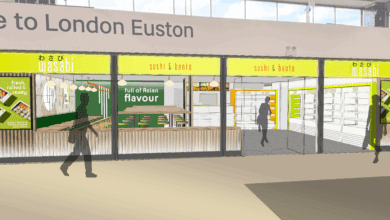What’s behind increased hospitality churn?
Catering Today talks to Jane Pendlebury, CEO of HOSPA and Saxon Moseley, partner and head of leisure and hospitality at RSM, about why so many new venues have opened since 2020, the role multi-site operators have played in this and what hopes there are for independent businesses looking for a start

Register to get 1 free article
Reveal the article below by registering for our email newsletter.
Want unlimited access? View Plans
Already have an account? Sign in
In recent years the prevailing narrative in the hospitality industry has been that venues are closing at an alarming rate. Data from CGA revealed that 27,951 hospitality venues closed their doors between March 2020 and September 2024 at a rate of 119 per week. However, what gets lost in this narrative is the large number of sites that have opened in this time, 12,767 to be exact, either in vacated premises or in converted or new-build sites.
The net result is that the estate of licensed premises has shrunk by 13% in four years, but 13% of today’s sector is occupied by venues that have opened during that time. Alongside this, a third (32%) of today’s venues have launched in the last 10 years. So how are people still able to open new venues in such a difficult market, how much of this is down to multi-site operators and what does an independent venue need to do to survive?
Why so many new venues and how?
The first question to answer is why so many venues have closed since 2010. The simple answers are the pandemic and rising costs combined with changing consumer habits post-pandemic. As Saxon Moseley, partner and head of leisure and hospitality, explains, once household budgets were squeezed, especially following the energy cost crisis caused by the Russian invasion of Ukraine in 2022, the first thing people cut back on was eating and drinking out. Add in Brexit making it harder to find and retain staff and you have fertile ground for hospitality closures.
But none of this is new information. What is new is the thousands of venues which have come along to replace those which have closed. Jane Pendlebury, CEO of HOSPA, suggests that many of the new openings post-pandemic came as a result of people looking to chase their dreams. The pandemic put a pause on a lot of people’s lives and gave them a chance to reevaluate what they wanted. For many that was to open a restaurant or cafe and many chose to do so without the requisite knowledge of what is needed to run a successful hospitality business.
“The desire for flexibility and a shift in career ambitions post-pandemic may have driven some to pursue their dream of owning a restaurant or café, which on the face of things, seems like a nice lifestyle business, but without fully appreciating the challenges that come with it,” says Pendlebury.
The number of people getting into the business and failing meant that there have been plenty of vacant sites to be acquired, quite often by companies which already had existing sites. As Moseley explains, being second into a new hospitality venue can be quite an advantage. Once you have a site that has already been set up as a hospitality business it cuts a lot of the initial costs. Any new operator likely will not have to install a new kitchen, front of house or even smaller things like toilets.
Moseley shares an anecdote of a business that went under a few months ago which RSM was acting for. He explains that the firm had lots of interest in the business but rather than buyers looking to acquire the business as a whole they were looking to acquire individual sites. This shows us that plenty of companies are looking to expand their operations and many of them have a clear idea of where they want to set up. Moseley adds that some firms such as Gail’s and Popeyes are developing AI models to help them decide on where they should expand to next.
The role of multi-site operators
The inescapable theme around a lot of these new openings is multi-site operators, be it big chains or smaller companies who already have successful existing sites. The first thing to note is that it is much easier for a multi-site group to open a new venue. They already have the existing resources to open a new site and will have experience of successfully opening at least one site, but in the main most of these operators will have expanded before. This means that there is less risk involved for them.
Alongside this, multi-site groups will likely also have the ability and experience to exit a site should it turn out badly. This also comes back to the theme of being second into a venue. If an operator has built or fitted a completely new restaurant at some expense they are likely to cling on till it is absolutely no longer viable financially. However, a bigger company, especially one that has moved into an already existing site, will happily move on from a site should it no longer make sense financially. They are also likely to have the resources and contacts to make this happen as efficiently as possible.
Is more multi-site venues a problem?
If more and more sites are being hoovered up by multi-site operators, squeezing out independent and smaller businesses, does this bode well for the health of the industry overall? Where will the new crop of restaurants and brands come from? The answer to this could be venues such as Boxpark and Market Halls, where a number of operators are able to have a presence, at a much lower cost.
“These spaces have become increasingly popular as consumer demand for food delivery grows, reducing the need for traditional restaurant setups with seating and the various bells and whistles,” Pendlebury says.
The street food concepts that these sorts of venues attract are low cost and easy to set up, meaning that they are far more accessible to start-up entrepreneurs. They also carry less risk to the operators should their concept end up not being popular. They do not have to worry about offloading an entire venue, they can exit or let their contract expire and it is up to the company that owns the food hall to find a replacement. On the bright side, if the concept is popular, then it can allow the business to grow, with a tried and tested brand.
Moseley raises the example of Franco Manca. The sourdough pizza brand started as a single stall in Brixton Market and has risen to be one of the bigger brands in the country with over 100 sites, and a genuine hope for those looking to make their mark in the hospitality space.
Hope for the independent
With all that said, it is still an awfully difficult market to break into and survive. It still remains the case that surviving the first year is something to be celebrated. However, there are lots of things that any new venture can do to give the best chance of success. Both Pendlebury and Moseley agree that research and knowing your market are the two most important things anyone can do to give a business the best chance of success. As Moseley states, “there aren’t many casual dining brands in Mayfair”. If you have the chance to acquire a venue you have to make sure you are offering the local area something it needs, there’s no point opening a new curry house on Brick Lane.
Once opened it’s all about making the numbers stack up. Moseley posits that you can sell millions of burgers but if your rent is astronomical then you are in for a real awakening. For Pendlebury, it’s all about keeping costs controlled. You need favourable lease terms and good deals with suppliers while also being prepared to make changes as necessary. “Flexibility and innovation will be key to long-term success, as it always has been in the hospitality industry,” adds Pendlebury.







